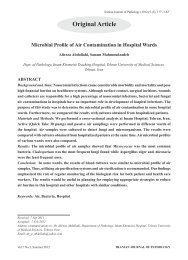World Health Organization Classification of Tumours Pathology and ...
World Health Organization Classification of Tumours Pathology and ...
World Health Organization Classification of Tumours Pathology and ...
You also want an ePaper? Increase the reach of your titles
YUMPU automatically turns print PDFs into web optimized ePapers that Google loves.
Fig. 1.08 Hereditary papillary renal cancer (HPRC)with multiple, bilateral papillary RCC.Fig. 1.09 Germline mutations <strong>of</strong> the MET oncogenein hereditary papillary renal cell carcinoma (HPRC).members develop the disease by theago <strong>of</strong> 55 years {2327}. Extrarenal manifestations<strong>of</strong> HPRC have not been identified.Papillary renal cell carcinomaBHD patients develop myriad papillarytumours, ranging from microscopiclesions to clinically symptomatic carcinomas{1979}. The histological pattern hasbeen termed papillary renal carcinomatype 1 <strong>and</strong> is characterized by papillaryor tubulo-papillary architecture verysimilar to papillary renal cell carcinoma,type 1.GeneticsResponsible for the disease are activatingmutations <strong>of</strong> the MET oncogenewhich maps to chromosome 7q31. METcodes for a receptor tyrosine kinase{799,1212,1213,1570,2326,2327,2926,2928}. Its lig<strong>and</strong> is hepatocyte growthfactor (HGFR). Mutations in exons 16to 19, ie the tyrosine kinase domain causesa lig<strong>and</strong>-independent constitutiveactivation.Duplication <strong>of</strong> the mutant chromosome 7leading to trisomy is present in a majority<strong>of</strong> HPRC tumours {768,845,1996,2032,2937}.ManagementFor patients with confirmed germlinemutation, annual abdominal CT imagingis recommended.Hereditary leiomyomatosis <strong>and</strong>renal cell cancer (HLRCC)DefinitionHereditary leiomyomatosis <strong>and</strong> renal cellcancer (HLRCC, MIN no: 605839) is anautosomal dominant tumour syndromecaused by germline mutations in the FHgene. It is characterized by predispositionto benign leiomyomas <strong>of</strong> the skin <strong>and</strong>the uterus. Predisposition to renal cellcarcinoma <strong>and</strong> uterine leiomyosarcomais present in a subset <strong>of</strong> families.MIM No. 605839 {1679}.Diagnostic criteriaThe definitive diagnosis <strong>of</strong> HLRCC relieson FH mutation detection. The presence<strong>of</strong> multiple leiomyomas <strong>of</strong> the skin <strong>and</strong>the uterus papillary type 2 renal cancer,<strong>and</strong> early-onset uterine leiomyosarcomaare suggestive {51,52,1330,1450,1469,2632}.Renal cell cancerAt present, 26 patients with renal carcinomashave been identified in 11 familiesout <strong>of</strong> 105 (10%) {52,1329,1450,1469,2632}. The average age at onset is muchearlier than in sporadic kidney cancer;median 36 years in the Finnish <strong>and</strong> 44years in the North American patients,(range 18-90 years). The carcinomas aretypically solitary <strong>and</strong> unilateral {1450,2632}. The most patients have died <strong>of</strong>metastatic disease within five years afterdiagnosis. The peculiar histology <strong>of</strong> renalcancers in HLRCC originally led to identification<strong>of</strong> this syndrome {1450}.Typically, HLRCC renal cell carcinomasdisplay papillary type 2 histology <strong>and</strong>large cells with abundant eosinophiliccytoplasm, large nuclei, <strong>and</strong> prominentinclusion-like eosinophilic nucleoli. TheFuhrman nuclear grade is from 3 to 4.Most tumours stain positive for vimentin<strong>and</strong> negative for cytokeratin 7. Recently,three patients were identified havingeither collective duct carcinoma or oncocytictumour {52,2632}. Regular screeningfor kidney cancer is recommended,but optimal protocols have not yet beendetermined. Computer tomography <strong>and</strong>abdominal ultrasound have been proposed{1328,2632}. Moreover, as renalcell carcinoma is present only in a subset<strong>of</strong> families, there are no guidelines yet,whether the surveillance should be carriedout in all FH mutation families.AFig. 1.10 Hereditary papillary renal cell carcinoma (HPRC) A <strong>Tumours</strong> have a papillary or tubulo-papillaryarchitecture very similar to papillary renal cell carcinoma, type 1. Macrophages are frequently present inthe papillary cores. B Hereditary papillary renal cell carcinoma frequently react strongly <strong>and</strong> diffusely withantibody to cytokeratin 7.BLeiomyomas <strong>of</strong> the skin <strong>and</strong> uterusLeiomyomas <strong>of</strong> the skin <strong>and</strong> uterus arethe most common features <strong>of</strong> HLRCC,the penetrance being approximately85% {1328,2632}. The onset <strong>of</strong> cutaneousleiomyomas ranges from 10-47years, <strong>and</strong> uterine leiomyomas from 18-52 years (mean 30 years) {2632}.Clinically, cutaneous leiomyomas present18<strong>Tumours</strong> <strong>of</strong> the kidney



